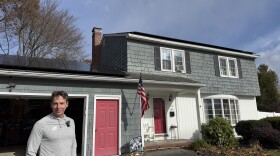For New Hampshire’s Seacoast, it’s no secret that climate change and the resulting rise in sea-level rise is one of the biggest challenges facing the region. But while the threat is well known, the ways Seacoast communities are preparing for it aren’t always what you’d expect. NHPR’s Jason Moon reports for our month-long series Life on the Seacoast.
In downtown Portsmouth, there’s this little red brick building that sits across the water from Peirce Island. It isn’t remarkable, just a windowless brick box with a set of gray doors.
But for Portsmouth’s Environmental Planner Peter Britz, those doors represent the front lines in the struggle to protect the city from a rising ocean.

“We’re looking at the outside of the pump station with doors and two steps up to the pump station. And the water has gotten basically to the bottom of the first step.”
Keeping water away from those doors is important to Britz because of what’s behind them – a major pump station for the city’s sewage system.
“When a big event like a hurricane or a flooding event happens on the coast or sea-level rise over the long term happens and water compromises this pump station, it essentially stops the ability to treat wastewater. And we don’t want that to happen.”
In other words, if the water reaches this door sill, the entire city of Portsmouth might not be able to flush the toilet.
“Keeping this protected is a big priority for the city.”
Finding vulnerabilities like this in the city’s infrastructure is something on Britz’s mind these days. He’s working on a sophisticated analysis of how water will enter the city during a flood to find more potential weak spots -- whether it’s a door sill that is too low or a culvert that is too narrow.
It’s just one of the ways communities around the Seacoast are preparing for a future with rising seas and bigger storms. Scientists predict the average high tide could rise by as much as 2 feet by the year 2050, and by 2100, it could be over 6 feet higher than it is today.
But like Britz’s work in Portsmouth, many of the efforts around the Seacoast to prepare don’t involve building huge levees or erecting massive sea-walls.
In fact, at nearby Cutts Cove in Portsmouth, they’re doing the opposite.
David Burdick with the University of New Hampshire is showing me what might be the most counter-intuitive solution to climate readiness: tearing down an existing sea wall.
“This will be the first living shoreline where we’re trying to get rid of a non-living shoreline.”
What Burdick means by non-living is something called riprap which currently lines Cutts Cove – it’s basically a bank of large rocks piled along the water’s edge. This type of hard coastal armoring has long been a hallmark of how coastal communities have protected their shorelines. Now, Burdick and a team of engineers are planning to replace a large section of the steep rock bank with a gradually sloping salt marsh – a living shoreline.
“That salt marsh will grow in elevation as it’s flooded with salt water. It collects sediments and will actually build in elevation, protecting the shoreline behind it.”
The marsh will provide protection for the shoreline, just like the riprap, but it will also do something that rock wall can’t: provide an important habitat for wildlife.
“If we create systems where we don’t have the salt marshes, like these walls, we’re not going to have the fish. So if we want fish, we want healthy habitats we’re going to have to have a combination of hard structures and soft structures.”
While Burdick is busy creating natural habitats that protect shorelines, the city of Dover is hoping to do something similar. Only in this case, the habitat is for people and businesses.
City Planner Steve Bird and engineer Rob Roseen show me a patch of overgrown land near the Cocecho River in Dover. It used to be the site of a factory, then the city’s wastewater treatment plant. Today, Bird and Roseen imagine it as a mixed-use development with apartments, retail spaces, and a waterfront park.

They want to use a wholesale redevelopment of this spot as an opportunity to fortify 2000 feet of waterfront property. The way to do that, Roseen says, is to build with the knowledge that like it or not, the area will flood.
“You plan for storms to occur. So there would be certain spaces here where we would say alright when this area floods, we’re going to put the floods through here and we’re going to design for it so that there’s minimal impact.”
If all goes according to plan, the waterfront park will act as a sort of sponge for the structures in the development, protecting them from the effects of climate change for decades to come.
“These types of changes in planning are very much like you would see a change in electrical efficiency or fire safety or water quality. It’s just an incremental cost.”
Incremental costs that will likely show up in ways large, small, and unexpected over the next several decades as each of New Hampshire’s seacoast communities try to adapt to a new reality.









